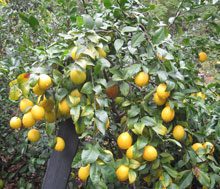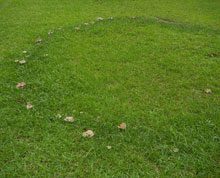 I may be among the few human beings yet alive who can remember – and with fond appreciation – the superb actress, singer, and comedic performer, Beatrice Lilly. Indeed, she was known during her long career as the funniest woman alive.
I may be among the few human beings yet alive who can remember – and with fond appreciation – the superb actress, singer, and comedic performer, Beatrice Lilly. Indeed, she was known during her long career as the funniest woman alive.
Of the many delightful, funny, and often outrageous routines Miss Lilly was famous for, the one which I most strongly remember and still cherish is her singing recitation of the Rose Fyleman poem, There Are Fairies At The Bottom Of Our Garden, from about 1918. It is a children’s poem as written, but Miss Lilly managed to evoke repeated double-entendre implications throughout the sweet story. Double-entendre was what made her famous – that, and becoming the wife of an English Baronet, properly entitling her, “Lady Peel.”
Beatrice Lilly and her signature song came to mind this week as I walked into the back yard toward the old barn. It had been a lovely spring, for the most part, and there has been a substantial amount of rain all season. The grass – and the weeds, too – have grown quite fast all season, requiring mowing more frequently than I am anxious to do.
Nearing the barn and beneath one of the huge old pecan trees, luxuriant in its fresh bright green leaves, I spotted an arc, a nearly complete circle of small white mushrooms growing up through the dense green grass. A Fairy Ring. An Elf Circle. A Pixie Ring.
These are fascinating constructions, appearing as if by magic. The circular form is often nearly perfect. Anyone would wonder how it came to be, and it is not hard to imagine that fairies or pixies or elves might have had a frolic in the lawn the previous evening.
The real story is slightly less enchanting. Often, it appears that a ring of fungi may have started near the center of the ring several seasons before, growing from the buried remains of a dead tree, a stump. Feeding on the rotting wood and organic matter in the soil, the fungus would have grown outward on its tiny underground filaments, spreading radially from the center. Periodically, the filaments (mycorrhizae) mature enough to send up fruiting bodies to reproduce by sending out spores. These fruiting bodies, these reproductive structures, are the mushrooms we see.
Mushrooms, and the other fungi popping up in your flower beds, on the roots of your shrubbery and small trees, on your lovely and expensive mulch, seem sometimes to evoke panic in the gardener. Usually, it is safe to relax and appreciate them, for they typically signify some very beneficial aspects of your soil. They are a sign of plentiful organic matter in the soil, and one of the miraculous functions of those tiny underground fungal filaments called mycorrhizae is to help convert the natural compounds, minerals, and substances in the soil into a form useful to the plants growing nearby and, indeed, useful to the fungus itself. There’s an increasing appreciation of this functional symbiosis, such that there are soils supplements which add mycorrhizae to your soil to help your garden grow . . . essentially, seeding mushrooms and fungi into soil that is lacking them.
Every year, gardeners in a panic will send in photos of scary things growing up in their flower beds. “What is this horrid thing coming up in the mulch? It looks obscene!” “This scared me to death this morning! I thought I’d found a body!” “What threw this up – a raccoon? A dog?” “Are these snake eggs?”
Ah, dear reader. I have your answers…
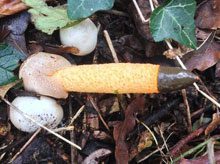 The Dog’s Penis Fungus
The Dog’s Penis Fungus
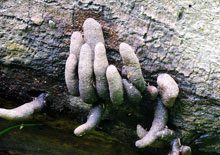 Dead Man’s Fingers Fungus
Dead Man’s Fingers Fungus
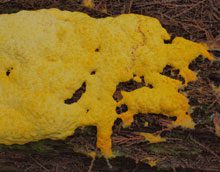 Dog Vomit Fungus
Dog Vomit Fungus
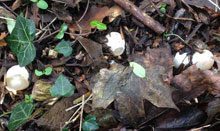 Gasteromycete Fungus
Gasteromycete Fungus
Photo Credits: The Fairy Ring Image is by the author; The Dog’s Penis Image is by First Nature; The Dead Man’s Fingers Image is by Ralph the Gypsy; and the Dog Vomit Image is by Kokannee Creek Nature Center, BC

